Here is the GitRepository of the source code.
In the "Linear Interpolation" section This article discusses how to interpolate the values when the lines are oblique.
For example, for Case#2 it has the following calculation:
I have implemented the interpolation as follows:
public class Square
{
public Point A { get; set; }//bottom left point
public Point B { get; set; }//bottom right point
public Point C { get; set; }//top right point
public Point D { get; set; }//top left point
public double A_data { get; set; }//bottom left data
public double B_data { get; set; }//bottom right data
public double C_data { get; set; }//top roght data
public double D_data { get; set; }//top left data
public Square()
{
A = new Point();
B = new Point();
C = new Point();
D = new Point();
}
private double GetCaseId(double threshold)
{
int caseId = 0;
if (A_data >= threshold)
{
caseId |= 1;
}
if (B_data >= threshold)
{
caseId |= 2;
}
if (C_data >= threshold)
{
caseId |= 4;
}
if (D_data >= threshold)
{
caseId |= 8;
}
return caseId;
}
public List<Line> GetLines(double Threshold)
{
List<Line> linesList = new List<Line>();
double caseId = GetCaseId(Threshold);
if (caseId == 0) {/*do nothing*/ }
if (caseId == 15) {/*do nothing*/ }
if ((caseId == 1) || (caseId == 14))
{
double pX = B.X + (A.X - B.X) * ((1 - B_data) / (A_data - B_data));
double pY = B.Y;
Point p = new Point(pX, pY);
double qX = D.X;
double qY = D.Y + (A.Y - D.Y) * ((1 - D_data) / (A_data - D_data));
Point q = new Point(qX, qY);
Line line = new Line(p, q);
linesList.Add(line);
}
/*2==13*/
if ((caseId == 2) || (caseId == 13))//B
{
double pX = A.X + (B.X - A.X) * ((1 - A_data) / (B_data - A_data));
double pY = A.Y;
Point p = new Point(pX, pY);
double qX = C.X;
double qY = C.Y + (B.Y - C.Y) * ((1 - C_data) / (B_data - C_data));
Point q = new Point(qX, qY);
Line line = new Line(p, q);
linesList.Add(line);
}
/*3==12*/
if ((caseId == 3) || (caseId == 12))
{
double pX = A.X;
double pY = A.Y + (D.Y - A.Y) * ((1 - A_data) / (D_data - A_data));
Point p = new Point(pX, pY);
double qX = C.X;
double qY = C.Y + (B.Y - C.Y) * ((1 - C_data) / (B_data - C_data));
Point q = new Point(qX, qY);
Line line = new Line(p, q);
linesList.Add(line);
}
/*4==11*/
if ((caseId == 4) || (caseId == 11))
{
double pX = D.X + (C.X - D.X) * ((1 - D_data) / (C_data - D_data));
double pY = D.Y;
Point p = new Point(pX, pY);
double qX = B.X;
double qY = B.Y + (C.Y - B.Y) * ((1 - B_data) / (C_data - B_data));
Point q = new Point(qX, qY);
Line line = new Line(p, q);
linesList.Add(line);
}
/*6==9*/
if ((caseId == 6) || (caseId == 9))
{
double pX = A.X + (B.X - A.X) * ((1 - A_data) / (B_data - A_data));
double pY = A.Y;
Point p = new Point(pX, pY);
double qX = C.X + (D.X - C.X) * ((1 - C_data) / (D_data - C_data));
double qY = C.Y;
Point q = new Point(qX, qY);
Line line = new Line(p, q);
linesList.Add(line);
}
/*7==8*/
if ((caseId == 7) || (caseId == 8))
{
double pX = C.X + (D.X - C.X) * ((1 - C_data) / (D_data - C_data));
double pY = C.Y;
Point p = new Point(pX, pY);
double qX = A.X;
double qY = A.Y + (D.Y - A.Y) * ((1 - A_data) / (D_data - A_data));
Point q = new Point(qX, qY);
Line line = new Line(p, q);
linesList.Add(line);
}
/*ambiguous case*/
if (caseId == 5)
{
double pX1 = A.X + (B.X - A.X) * ((1 - A_data) / (B_data - A_data));
double pY1 = A.Y;
Point p1 = new Point(pX1, pY1);
double qX1 = C.X;
double qY1 = C.Y + (B.Y - C.Y) * ((1 - C_data) / (B_data - C_data));
Point q1 = new Point(qX1, qY1);
Line line1 = new Line(p1, q1);
double pX2 = C.X + (D.X - C.X) * ((1 - C_data) / (D_data - C_data));
double pY2 = C.Y;
Point p2 = new Point(pX2, pY2);
double qX2 = A.X;
double qY2 = A.Y + (D.Y - A.Y) * ((1 - A_data) / (D_data - A_data));
Point q2 = new Point(qX2, qY2);
Line line2 = new Line(p2, q2);
linesList.Add(line1);
linesList.Add(line2);
}
if (caseId == 10)
{
double pX1 = B.X + (A.X - B.X) * ((1 - B_data) / (A_data - B_data));
double pY1 = B.Y;
Point p1 = new Point(pX1, pY1);
double qX1 = D.X;
double qY1 = D.Y + (A.Y - D.Y) * ((1 - D_data) / (A_data - D_data));
Point q1 = new Point(qX1, qY1);
Line line1 = new Line(p1, q1);
double pX2 = D.X + (C.X - D.X) * ((1 - D_data) / (C_data - D_data));
double pY2 = D.Y;
Point p2 = new Point(pX2, pY2);
double qX2 = B.X;
double qY2 = B.Y + (C.Y - B.Y) * ((1 - B_data) / (C_data - B_data));
Point q2 = new Point(qX2, qY2);
Line line2 = new Line(p2, q2);
linesList.Add(line1);
linesList.Add(line2);
}
return linesList;
}
But, this is not working properly.
Can anyone check the Interpolation part and tell me what went wrong?

